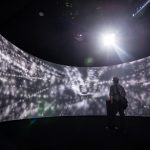Daria Tsoupikova
Most Recent Affiliation(s):
- University of Illinois at Chicago, School of Design, School of Art and Design and Electronic Visualization Laboratory (EVL), Associate Professor
ISEA Bio(s) Available:
ISEA2016
Tsoupikova’s creative practice examines the technological revolution in the field of design, focusing on Virtual Reality (VR) as the ultimate form of advanced technology for artistic expression. Since 2002 she has been creating VR applications and networked multi-user environments for VR projection systems, such as Cave Automatic Virtual Environment (CAVE and CAVE2). These works investigate computational creativity to design real life applications that advance healthcare, education and social change. Prior to joining academia, she worked for several design companies including global Siegel+Gale and the New York-based Firstborn designing and developing interactive web applications for Citigroup, General Electric, New York Racing Association (NYRA), Miradiant Global Network, NETGEAR, Redken, and other clients.
She is an Associate Professor in the School of Design and the Electronic Visualization Laboratory (EVL) at the University of Illinois at Chicago where she is responsible for the integration of advanced technologies such as Virtual Reality, Visualization, Game Design, Mobile Design and Creative Coding into curricular and professional practice. She has been an active leader and advocate for the development of cross-disciplinary collaborations, courses, and professional applications.
ISEA2015
Daria Tsoupikova, University of Illinois at Chicago, IL, USA, is an Associate Professor in the School of Design and the Electronic Visualization Laboratory (EVL) at the University of Illinois at Chicago. Her research and artwork include development of virtual reality (VR) art
projects and networked multi-user exhibitions for VR projection systems, such as the Cave Automatic Virtual Environment theatre (CAVE2™), as well as the design of interactive educational multimedia for children. Her VR research, publications and artwork explore the relationship between the aesthetics of virtual environments, traditional arts, and the effect of VR aesthetics on the user’s perceptions and emotions. Her work lies at the crossroads of artistic and technological innovation, and explores the potential of new media and interactivity in relation to traditional arts. Her current works are applications of computer graphics art to various research domains such as educational multimedia, cultural heritage and virtual rehabilitation for stroke survivors. Her work was exhibited and published at ACM SIGGRAPH, IEEE VR, ISEA and many other venues.
Website:
Last Known Location:
- Chicago, Illinois, United States of America
International Programme Committee:
Art Events:

Hearts and Minds: The Interrogation...
Categories: [Art Exhibition] [Projection / Video Mapping] [Screening] [Animation] [Video Art]
[ISEA2016]
Presentations:
-
Title: Aesthetics as a Medium
Symposium:-
ISEA2008
| Type(s):
Title: Media Arts in Support of Science Education
Symposium:-
ISEA2012
| Type(s):
Title: Hearts and Minds: The Residue of War
Symposium:




